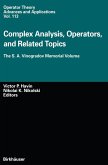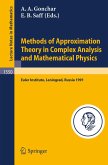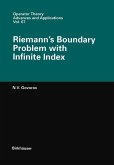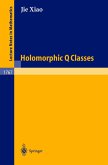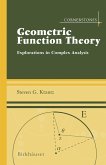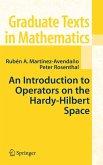

Alle Infos zum eBook verschenken

- Format: PDF
- Merkliste
- Auf die Merkliste
- Bewerten Bewerten
- Teilen
- Produkt teilen
- Produkterinnerung
- Produkterinnerung

Hier können Sie sich einloggen

Bitte loggen Sie sich zunächst in Ihr Kundenkonto ein oder registrieren Sie sich bei bücher.de, um das eBook-Abo tolino select nutzen zu können.
These notes are based on lectures given at the University of Virginia over the past twenty years. They may be viewed as a course in function theory for nonspecialists. Chapters 1-6 give the function-theoretic background to Hardy Classes and Operator Theory, Oxford Mathematical Monographs, Oxford University Press, New York, 1985. These chapters were written first, and they were origi nally intended to be a part of that book. Half-plane function theory continues to be useful for applications and is a focal point in our account (Chapters 5 and 6). The theory of Hardy and Nevanlinna classes is…mehr
- Geräte: PC
- ohne Kopierschutz
- eBook Hilfe
- Größe: 16.01MB
![Complex Analysis, Operators, and Related Topics (eBook, PDF) Complex Analysis, Operators, and Related Topics (eBook, PDF)]() Complex Analysis, Operators, and Related Topics (eBook, PDF)73,95 €
Complex Analysis, Operators, and Related Topics (eBook, PDF)73,95 €![Topics in Interpolation Theory (eBook, PDF) Topics in Interpolation Theory (eBook, PDF)]() Topics in Interpolation Theory (eBook, PDF)40,95 €
Topics in Interpolation Theory (eBook, PDF)40,95 €![Methods of Approximation Theory in Complex Analysis and Mathematical Physics (eBook, PDF) Methods of Approximation Theory in Complex Analysis and Mathematical Physics (eBook, PDF)]() Methods of Approximation Theory in Complex Analysis and Mathematical Physics (eBook, PDF)30,95 €
Methods of Approximation Theory in Complex Analysis and Mathematical Physics (eBook, PDF)30,95 €![Riemann's Boundary Problem with Infinite Index (eBook, PDF) Riemann's Boundary Problem with Infinite Index (eBook, PDF)]() Nikolaj V. GovorovRiemann's Boundary Problem with Infinite Index (eBook, PDF)73,95 €
Nikolaj V. GovorovRiemann's Boundary Problem with Infinite Index (eBook, PDF)73,95 €![Holomorphic Q Classes (eBook, PDF) Holomorphic Q Classes (eBook, PDF)]() Jie XiaoHolomorphic Q Classes (eBook, PDF)23,95 €
Jie XiaoHolomorphic Q Classes (eBook, PDF)23,95 €![Geometric Function Theory (eBook, PDF) Geometric Function Theory (eBook, PDF)]() Steven G. KrantzGeometric Function Theory (eBook, PDF)73,95 €
Steven G. KrantzGeometric Function Theory (eBook, PDF)73,95 €![An Introduction to Operators on the Hardy-Hilbert Space (eBook, PDF) An Introduction to Operators on the Hardy-Hilbert Space (eBook, PDF)]() Ruben A. Martinez-AvendanoAn Introduction to Operators on the Hardy-Hilbert Space (eBook, PDF)44,95 €
Ruben A. Martinez-AvendanoAn Introduction to Operators on the Hardy-Hilbert Space (eBook, PDF)44,95 €-
-
-
Dieser Download kann aus rechtlichen Gründen nur mit Rechnungsadresse in A, B, BG, CY, CZ, D, DK, EW, E, FIN, F, GR, HR, H, IRL, I, LT, L, LR, M, NL, PL, P, R, S, SLO, SK ausgeliefert werden.
- Produktdetails
- Verlag: Birkhäuser Basel
- Seitenzahl: 250
- Erscheinungstermin: 6. Dezember 2012
- Englisch
- ISBN-13: 9783034885201
- Artikelnr.: 53174287
- Verlag: Birkhäuser Basel
- Seitenzahl: 250
- Erscheinungstermin: 6. Dezember 2012
- Englisch
- ISBN-13: 9783034885201
- Artikelnr.: 53174287

